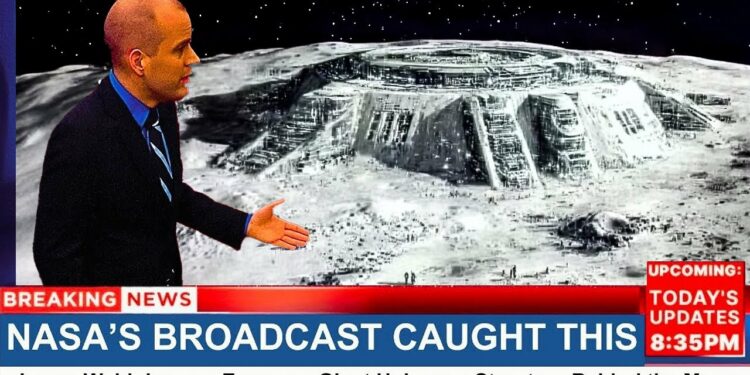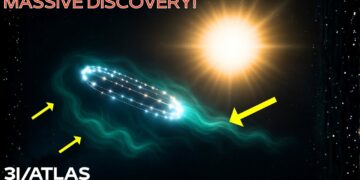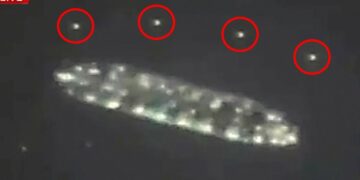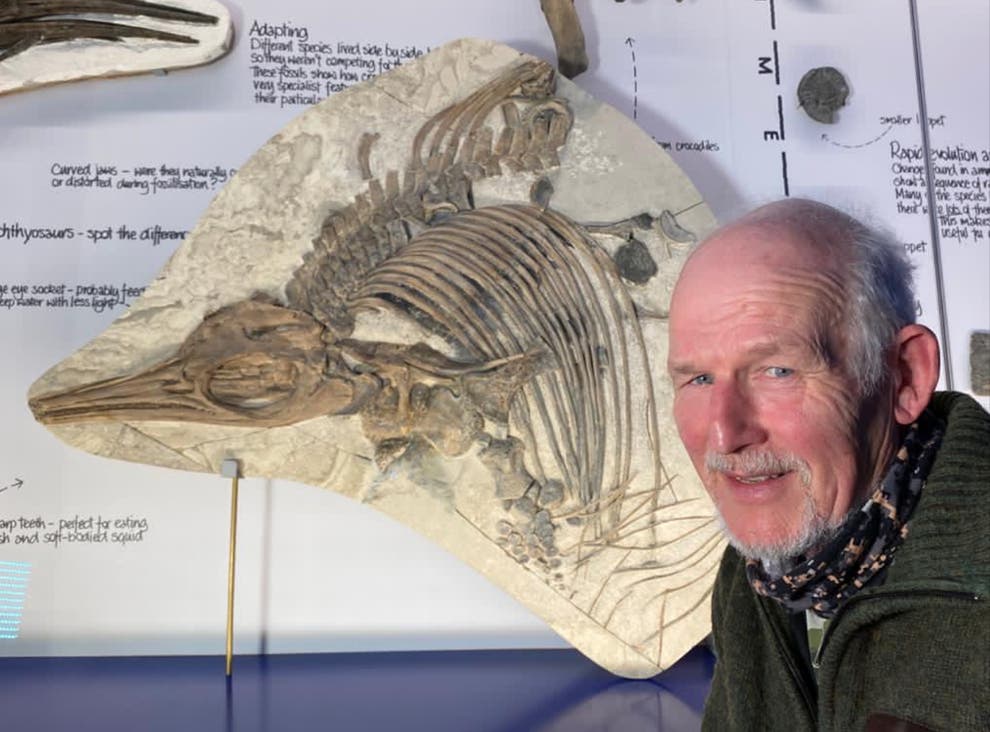We must rewrite every high school textbook on Earth. The universe is not what we thought. Has NASA discovered something they’re keeping from us? Recently, NASA stunned the world with a revelation about our moon that left scientists speechless. What did their latest scans uncover beneath the lunar surface? The truth about what’s up there could upend everything we believe.
The Shocking Press Conference That Started It All
The scientific community is still reeling from last month’s events. During what was meant to be a routine NASA briefing on the Artemis moon program, renowned physicist Michio Kaku shocked the room. Known for his calm and methodical demeanor, Kaku appeared visibly uneasy when questioned about recent lunar scans. His usual confidence faded as he carefully selected his words, stating that certain findings needed further study before public disclosure. The room went silent. NASA officials swiftly shifted the conversation, but the moment was already captured. Leaked footage shows Kaku being escorted offstage by agency staff after attempting to answer a question about structural anomalies beneath the lunar surface. What did he see in the data?
Former NASA engineer Thomas Mitchell, who left the agency last year, caused a stir when he tweeted that Kaku’s reaction was understandable given the findings. The tweet vanished within hours, but screenshots spread rapidly online. Longtime colleagues of Kaku noted his sudden cancellation of several TV appearances, with one producer anonymously revealing that Kaku cited “personal obligations to review sensitive material” as his reason. When Kaku reappeared two weeks later on a science podcast, he dodged all moon-related questions despite the hosts’ persistence.
No one anticipated what unfolded that Tuesday morning at NASA headquarters. Michio Kaku, the charismatic physicist familiar from TV, entered looking pale and exhausted. Reporters immediately sensed something was off—this wasn’t the confident Kaku they knew. When questions turned to recent lunar scans, the atmosphere grew tense. Kaku’s hands trembled as he shuffled his notes, and NASA officials exchanged nervous glances. Instead of his usual clear explanations, he gave vague, cautious responses, avoiding specifics about the lunar orbiter’s discoveries. The real shock came when a reporter asked about unusual patterns detected beneath the surface. Kaku froze for 17 seconds, staring at his papers before a NASA official intervened. Moments later, he was escorted offstage mid-question. Videos of the incident went viral, with body language experts noting clear signs of stress. Kaku canceled three TV appearances that week and, when he finally resurfaced, consistently sidestepped moon-related questions.
Unexplained Lunar Density Readings
NASA’s latest lunar mapping satellites have revealed something that defies scientific understanding. Using advanced density-scanning technology, the orbiter detected massive concentrations beneath the lunar surface that don’t match any known natural formations. These anomalies, located under the Shackleton Crater near the moon’s south pole, are five times denser than surrounding moon rock and arranged in eerily regular patterns. Initially, scientists suspected equipment errors, but three recalibrations confirmed the readings. The density signatures don’t resemble metallic asteroid remnants, volcanic formations, or any documented lunar features. Most troubling, statistical analysis shows these clusters form geometric configurations far too precise to be natural. Additional scans from different orbital angles revealed the same patterns with perfect consistency.
Michio Kaku was among the first civilian scientists to review this data, reportedly spending three days analyzing it before his public appearance. Even more concerning, the formations appear to shift position slightly over time—something geologically impossible. A scientific paper documenting these movements was set for publication in a major journal but was mysteriously withdrawn. Several researchers involved in the analysis have gone silent on social media, with one removing all professional affiliations from their profiles.
NASA’s newest satellites found dense spots 18 miles beneath the Shackleton Crater that are five times heavier than surrounding rock. Initially dismissed as equipment failure, the readings held after multiple checks. These dense patches form perfect geometric shapes—straight lines, precise angles, and exact circles—unlike anything in nature. Stranger still, follow-up scans showed these areas had moved slightly while retaining their perfect shapes. The material doesn’t match asteroid fragments or lava flows, and its movement defies explanation. The research team requested more scans, which confirmed the same patterns. Most of the team has since gone quiet, and their planned paper vanished without explanation.
Mysterious Radio Emissions
For years, NASA dismissed weak radio signals from the moon as interference or equipment issues. That changed with the latest lunar orbiter, equipped with highly sensitive instruments. It detected structured radio pulses emanating from the exact locations of the density anomalies. These signals follow patterns that don’t align with natural phenomena like solar interference or cosmic cycles. They repeat at regular intervals, and their intensity spiked dramatically just before Kaku’s press conference. A 30-second transmission captured by the orbiter showed non-random sequencing, suggesting information rather than noise. Insiders say Kaku canceled all appointments and called an emergency meeting with signal-processing experts after reviewing this data. The signals don’t match anything in NASA’s extensive database and intensify during lunar eclipses, syncing perfectly with Earth’s position relative to the moon. Their strength has increased by 4% monthly, ruling out echoes from past human missions. NASA has deployed specialized equipment at three major radio telescopes to monitor these emissions, using pattern-recognition software typically reserved for searching extraterrestrial signals.
Secret Lunar Mining Plans
After the density scans rattled Kaku, space agencies worldwide abruptly revised their moon mission timelines. China, Russia, and the U.S. prioritized landings near the Shackleton Crater, where the anomalies were detected. The official explanation—water ice deposits—doesn’t hold up, as lunar ice has been known for decades. Why the sudden urgency? Government contractors specializing in advanced mining technology received massive funding overnight. Companies producing vacuum-compatible drilling equipment saw their stock prices triple within a week. Mission payloads were classified immediately after Kaku’s press conference, and the equipment being prepared suggests deep extraction of extremely dense materials, not ice harvesting. An engineer designing space mining equipment revealed that his team was tasked with modifying drills to penetrate materials far denser than any known lunar substance, built to withstand extreme temperatures and pressures. International cooperation on these missions materialized rapidly, with rival nations sharing technology and resources for this lunar project.
Mysterious Lunar Seismic Activity
The moon was long considered geologically inactive, but six months ago, sensors detected tremors beneath the surface, centered exactly at the density anomalies. Unlike typical moonquakes caused by Earth’s gravity or meteor impacts, these vibrations occur every 13.7 hours, regardless of the moon’s position. The tremors originate 18 miles below the surface, creating perfect concentric circles, as if something is moving or activating in a controlled manner. Kaku reportedly spent an entire night reviewing this data, requesting additional information repeatedly. A seismic specialist noted that the patterns resemble artificial movement more than natural processes. The vibrations intensified when lunar rovers approached certain coordinates, prompting NASA to reroute missions without explanation. The agency also upgraded seismic monitoring equipment around lunar outposts, adding sensors to track these unusual vibrations.
Classified Satellite Images
High-resolution military satellite photos have captured unusual changes near the density anomalies. While NASA’s public images show nothing unusual, leaked classified photos reveal straight lines and geometric patterns in the lunar soil that appear and disappear between imaging sessions—impossible without active intervention on a windless, waterless moon. Thermal imaging detected heat signatures forming perfect geometric shapes that match the density readings and shift position in unison while maintaining their structure. After reviewing these images, Kaku requested raw data, suspecting manipulation. Three imaging experts independently concluded the patterns suggest artificial design. All lunar photography from military satellites was then reclassified at the highest security level, with access restricted even to NASA personnel. Amateur astronomers reported unusual light glints from the region before being asked by government officials to stop observing.
Sudden Military and Intelligence Interest
After the anomalous readings, military and intelligence agencies with little prior interest in space exploration redirected significant resources to lunar research. The Pentagon established a “Luna Security Operations” department with classified objectives and unprecedented funding. Combat-experienced military officers were reassigned to NASA’s lunar division overnight. Defense contractors received billions to develop lunar-specific technologies with defensive capabilities. Multiple countries expanded their space military programs, all focused on the moon. Intelligence agencies began recruiting scientists specializing in exotic materials and non-terrestrial environments. Kaku’s unusual behavior began after a private meeting with officials from these lunar security groups. Military-grade communications equipment was installed at observatories tracking the moon, with armed guards restricting data access.
Strange Lunar Samples
Recent lunar soil samples from the anomaly region behave unlike any known material. They maintain constant temperature, neither absorbing nor releasing heat, and emit electromagnetic pulses that disrupt electronics when exposed to certain light frequencies. Most disturbingly, the samples rearrange their molecular structure when unobserved, with significant changes documented overnight. Multiple labs reported identical behaviors, ruling out contamination. After examining the samples, Kaku requested testing under strict protocols for hazardous substances. Scheduled papers on these anomalies were delayed indefinitely, and researchers were required to sign strict NDAs. Some samples reportedly lost mass in sealed containers, with security footage showing no external interference. Kaku visibly tensed when asked about the samples in a recent interview, quickly changing the subject.
Mysterious Health Effects
Researchers analyzing the anomaly data or handling lunar samples reported unusual symptoms. Those studying the density readings experienced vivid dreams of geometric patterns, spatial disorientation, and compulsive urges to draw unexplained symbols. Medical exams found no physical cause, yet symptoms were consistent across teams. Sample handlers reported synchronized headaches and sensitivity to light frequencies matching the lunar radio signals. After visiting a facility documenting these effects, Kaku recommended enhanced safety protocols, citing “information contamination.” Brainwave scans of affected researchers revealed embedded geometric sequences matching the lunar density patterns. Several researchers requested transfers, describing “intrusive thoughts” that felt foreign. Health monitoring systems at sample storage facilities were upgraded with advanced neurological scanners.
Kaku’s Warning
Though cautious publicly, Kaku has hinted at his concerns. His recent lectures focus on humanity’s response to paradigm-shifting discoveries and the psychological impact of confirming we’re not alone. A leaked book proposal outlines preparing human consciousness for a cosmic restructuring. Kaku has funded research into societal resilience after “ontological shock” and assembled a team of anthropologists, psychologists, and religious scholars studying cultural collapse and end-time beliefs. He acquired remote properties with sophisticated communication equipment and moved his research archives to secure offline storage. Colleagues note his obsession with ancient myths depicting the moon as artificial or inhabited. Kaku canceled engagements coinciding with major lunar mission dates and emphasized how society integrates world-changing discoveries. When asked about the moon, he said, “Some truths require preparation,” before refusing further comment.























